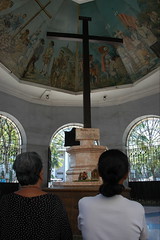In the middle of the commerce section fo Cebu City, near the Colon sits a monument of the Cross that Ferdinand Magellan brought with him.
Ferdinand Magellanwas the first European to come to the Philippines in 1521. Also known as Fernao Magalhaes or Fernando Magallanes, he was a Portuguese navigator working for the King of Spain. When he and his crews landed on Cebu island, they were met by a native chief, Rajah Humabon. Having befriend him, Rajah Humabon, his wife and hundreds of his native warriors agreed to accept Christianity and were consequently baptised. Magellan planted a cross to signify this important event about the propagation of the Roman Catholic faith in what is now the Philippines. The original cross is reputedly encased in another wooden cross for protection, as people started chipping it away in the belief that it had miraculous healing powers. This prompted the government officials to encase it in tindalo wood and secured it inside a small chapel called "kiosk." Some say, however, that the original cross was actually destroyed as it took another 45 years (1565) before Cebu was visited again by another European (Miguel Lopez de Legazpi) who made it the first capital of the Spanish colony known as Las Islas Filipinas. The Magellan cross displayed here is said to be a replica of such cross. It is housed in a small chapel located in front of the present city hall of Cebu, along Magallanes Street (named in honor of Magellan).
Sadly, Magellan met his death under the hands of another Visayan chief, Lapu-Lapu, when he went to the nearby island of Mactan. Mactan now forms part of Cebu, in central Philippines. There, both the statues of Magellan and Lapu-Lapu proudly stand.

No comments:
Post a Comment